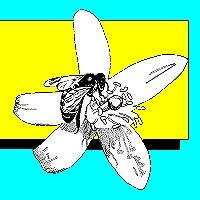APIS Volume 6, Number 8, August 1988

In this issue
- Panhandle Feeding Study
- More on Aldicarb Studies and Bees
- Pesticide Resistance: Historical Perspective
1988 Florida Panhandle Feeding Study
[Editor's note: The results of this study were subsequently published]:
Sanford, M.T. and W.B. Johnson. 1991. "A Florida Honey-Bee Feeding Study Using the Beltsville Bee Diet," BeeScience, Vol. 1, No. 2, pp. 72-76.
A cooperative venture is in the final stages of planning to address excessive winter loss in Florida's Panhandle. The effort will be directed by myself and the Apiary Bureau, Division of Plant Industry, Florida Agriculture and Consumer Services. We are presently signing up cooperators in several counties who have experienced severe losses. I presented a program to an enthusiastic group in June on the study's objectives.
The goal is to enable bees in the area to survive through a critical period in late winter and early spring. Cooperators will choose a number of colonies to enroll in the study. The study is designed to be under the control of the beekeeper and to minimize the risk of any one operation.
The study will analyze results using a statistic known as a "t-test." Cooperators will divide colonies into a number of identical pairs. The pairing of colonies is the most important step in the process. They must not be just paired, but absolutely identical in all possible respects. This means the queen stock is identical and each colony has the same number of adults and amounts of brood and food. Each identified pair will always be in the same location and have identical manipulations done to it throughout the season.
It doesn't matter whether pairs are weak, medium or strong, as long as the members of each pair are the same. Differences in management style among beekeepers is also not important, as long as what's done to one colony is done to the other. In fact, it is important to look at the widest possible spectrum of colony strengths and management styles.
One colony chosen at random in a pair will be fed the Beltsville Bee Diet ®. Bio-Serv, Inc., manufacturer of the diet, has kindly offered to supply some for the study. In addition, depending on the number of colonies enrolled, we may also be asking cooperators to contribute financial support to the study. We are now looking for beekeepers in Leon, Wakulla, Gadsden, Liberty, Franklin, Gulf, Calhoun, Jackson, and Jefferson counties who have suffered losses and are willing to become cooperators. Essential attributes for a cooperator will be a willingness to experiment, as well as approaching the study objectively.
MORE ON ALDICARB
The bumper orange crop this year has subdued complaints about bee loss because of aldicarb [Temik®] application in citrus groves (see January 1988 APIS). An effort to change the label restrictions so the material could be put on after citrus bloom has borne little fruit. A recent study published in The Citrus Industry, May, 1988 describes experiments on twenty-year-old 'Valencia' trees planted in well drained Astatula fine sand. The authors conclude that aldicarb metabolite in nectar should not be toxic to honey bees based on previous toxicity studies. Unfortunately, this conflicts with unpublished data from other sites in different soil conditions. Studies are continuing.
My conclusion in the January issue of APIS still holds. Whether aldicarb is problematic or not boils down to a classic case of "let the beekeeper beware." It is still extremely important to obtain as much information as possible on Temik® use in and near bee locations. Fortunately, Florida regulations help the beekeeper in this regard.
The August issue of Florida Environments, published by Florida Environments Publishing, Inc., P.O. Box 1617, 215 N. Main St., High Springs Florida 32643- 1617, ph 904/454-2007 provides background on these rules. Florida's regulations are tighter on the chemical than the U.S. Environmental Protection Agency's (EPA), according to an article authored by Agriculture Commissioner Doyle Conner.
An EPA plan proposed last May has many of the same elements which Florida already adopted in 1982, Commissioner Conner says. Florida's, however, appear to be more restrictive. The Florida aldicarb management program bans use within 300 feet of a drinking water well. Monitoring is done in coordination with the Department of Agriculture and Health and Rehabilitative Services. The Florida regulation also includes a requirement that an applicator file notice of intent to apply aldicarb 30 days prior to application. Also required is a history of use of aldicarb on the site for three years previous, the number of acres treated, amount and formulation used and location of drinking water wells on the site.
Florida limits the application of aldicarb to once a year in the dry months from January 1 through April 30. It also limits the amount applied to five pounds active ingredient per acre. This is half the label recommendation. Use in nurseries is limited to containerized plants. Finally, Florida regulations require posting of warning signs on sites to be treated at least 12 hours before treatment. They must remain in place for 30 days. Any wells within a treatment site must be posted with signs warning that the water is not to be consumed.
Those interested in the aldicarb and/or other environmental issues should pick up a copy of Florida Environments. It appears to be a forum whose time has come. A subscription costs $12.95 per year.
THE BIG PESTICIDE PICTURE
Dr. Robert Metcalf, called by some the dean of entomologists, provided a good deal of insight into the big pesticide picture during his visit to the University of Florida last year. His observations are particularly relevant as the beekeeping community searches for chemicals to control tracheal and Varroa mites. His remarks were summarized by Frank Abrahamson, editor of the Florida Grower and Rancher, in the December, 1987 issue.
Dr. Metcalf suggested we may have "won the battle, but lost the war" against pests. Because only 15 of 6000 harmful insects have been "almost" eradicated by the many pesticides developed over the years, he asserted there has not been a significant reduction in crop looses attributed to these pests.
In addition, insect resistance to chemicals is accelerating. In 1910, only one pest could not be controlled. By 1946, 14 species tolerated application of DDT. Presently, 500 insects are resistant to one or more compounds. In Florida, the serpentine leaf miner which attacks celery is resistant to 10 different insecticides.
Resistance develops faster as each new class of chemical is introduced according to Dr. Metcalf. It only takes a year or two for resistance to develop for synthetic pyrethroids, the newest group in the chemical arsenal.
Economics further complicates things. "It cost $1 million to develop a new chemical in 1955," Dr. Metcalf said. By 1984, this jumped to $45 million. As a result, 25 new compounds were introduced in 1960 but this declined to zero for 1987.
The trend toward consolidation of manufacturers also affects testing and manufacturing of new materials, according to Dr. Metcalf. Foreign corporations are dominant in purchasing smaller companies and less-profitable agriculture chemical divisions of major American industrial enterprises. The "survivors" are developing major long-term budgets for future traditional and biotechnological research and development programs.
Dr. Metcalf recommended the integrated pest management approach that is now gaining momentum as most appropriate for insect pest control. It combines chemical and natural biological control agents. Chemicals are only used when a pest reaches some economically damaging level. Dr. Metcalf says this approach is 50 to 90 percent more economical for the farmer than those previously used. In addition, use of integrated pest management will likely increase the effective life of pesticides that are now used. "Pesticides are indispensable in today's farming operations," he concluded, "but it is imperative that they be used judiciously."
Many of Dr. Metcalf's observations can be applied to chemicals that affect beekeeping. Witness that aldicarb is now sold by a European company, Rohm- Poulanc. It was originally made by Union Carbide, which sold its agricultural division to a foreign manufacturer.
Integrated pest management for Varroa control already includes a number of different approaches. Cultural control by dequeening can reduce brood available to mites. This is recommended in small-scale outfits in Germany now. In other types of operations, alternative manipulations may result in reduced mite populations.
Fluvalinate, the material of choice for Varroa control, is a synthetic pyrethroid. Resistance is expected to build up rapidly in mite populations, one of the reasons amitraz is now being tested at the University of Florida. Unfortunately, fluvalinate's effective life will be reduced because realistic thresholds for the mite are unknown (see June 1988 APIS). This will invariably mean a less-than-optimum use of the material. If no other compounds are introduced because of cost, beekeepers could well be left with no chemical control for Varroa. This is similar to the present situation where only a very few chemicals are labelled for wax moth fumigation and nothing exists to control chalkbrood.
Sincerely,
Malcolm T. Sanford
Bldg 970, Box 110620
University of Florida
Gainesville, FL 32611-0620
Phone (352) 392-1801, Ext. 143 FAX: (352)-392-0190
http://www.ifas.ufl.edu/~mts/apishtm/apis.htm
INTERNET Address: MTS@GNV.IFAS.UFL.EDU
©1988 M.T. Sanford "All Rights Reserved

















